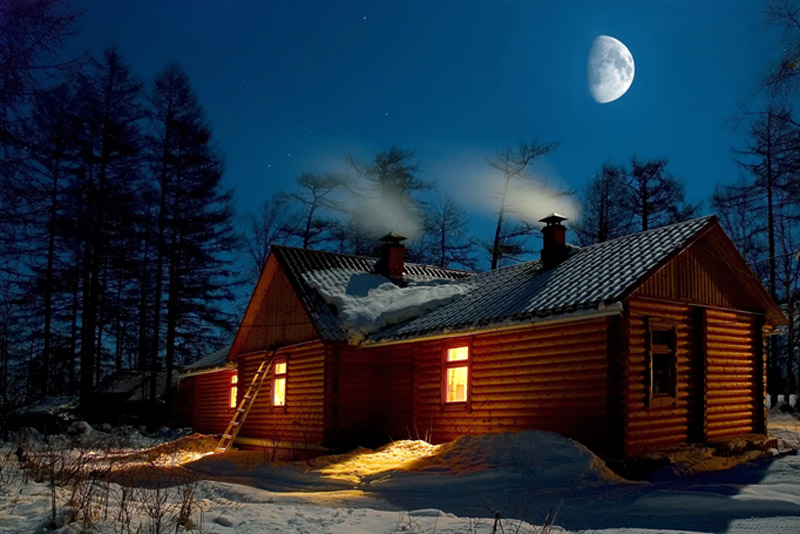Winter has already made its entrance, but there’s still time to ensure your log home is fully equipped to face the colder months ahead. At Performance Log Homes, we pride ourselves on our expertise in maintaining, renovating, and building log homes across seven states—from the sunny coasts of Florida to the picturesque mountains of North Carolina.
Leveraging the finest materials and most effective techniques, we’re dedicated to helping homeowners like you preserve the beauty and integrity of your cherished log homes.
Below, we outline fifteen tips to help your home stay safe and snug through the winter and beyond.
- Inspect and Repair Chinking and Caulking
Begin by closely inspecting the chinking and caulking around your home. Look for any signs of wear such as cracks or separation. Addressing these issues promptly can prevent cold air and moisture from penetrating your home, which is vital for keeping your living space warm and dry throughout the winter. - Apply Fresh Stain and Sealant
Protecting your log home’s wood from moisture and decay is crucial. Apply a fresh coat of stain and sealant to all exposed wood surfaces. Ensure that the wood is completely dry and that temperatures are suitable (ideally between 49-90 degrees Fahrenheit) to facilitate proper application and curing of the products. - Service Your Furnace and HVAC System
Have a professional inspect and service your furnace and HVAC system to ensure they are operating efficiently. An inefficient system can lead to higher energy costs and reduced comfort. Consider upgrading to a programmable thermostat to better control your home’s temperature, especially if you spend time away during the winter. - Prepare the Fireplace and Chimney
A well-maintained fireplace is essential for both warmth and atmosphere. Ensure your chimney is professionally cleaned to remove any soot or creosote buildup. Also, check the fireplace damper for proper operation to prevent heat from escaping unnecessarily. - Upgrade Windows and Doors
Inspect all windows and doors for drafts. Replace any worn-out weather stripping and consider installing storm windows or thermal curtains to enhance thermal insulation. These upgrades can significantly reduce heat loss and energy consumption. - Clean and Inspect Gutters and Downspouts
Remove any debris from your gutters and check that downspouts are directing water away from your home’s foundation. Proper maintenance of gutters and downspouts is crucial to prevent water damage and the formation of ice dams during the freezing weather. - Check the Roof
Conduct a thorough inspection of your roof to identify any missing, loose, or damaged shingles. Check the flashing around chimneys and vents. Timely repairs can prevent water damage and help maintain the home’s insulation integrity. - Insulate and Protect Plumbing
Insulate all exposed plumbing pipes to prevent them from freezing and bursting. Special attention should be given to pipes in unheated areas such as basements, attics, and crawl spaces. - Secure and Insulate the Foundation
Examine the foundation for any potential entry points for pests and seal them. Remove vegetation and debris around the foundation to reduce the likelihood of pest infestations and moisture-related issues. - Maintain Weather-Specific Equipment
Ensure that all your winter-specific equipment, like snow blowers and ice choppers, are in good working condition. Also, check that you have adequate supplies of ice melt and sand for icy conditions. - Inspect and Trim Landscaping
Trim any tree branches that might pose a risk to your home during storms. Managing your landscaping can prevent damage from snow and ice accumulation on overhanging branches. - Smoke and Carbon Monoxide Detectors
Test all smoke detectors and carbon monoxide detectors to ensure they are working correctly. Replace batteries as necessary to ensure these safety devices function properly when you most need them. - Prepare an Emergency Kit
Assemble an emergency kit that includes items like candles, matches, batteries, bottled water, and non-perishable food. This kit can be invaluable during unexpected power outages or severe winter storms. - Consider Thermographic Inspections
Invest in thermographic inspections to detect areas of poor insulation or hidden leaks. This advanced inspection can reveal issues that are not visible to the naked eye, allowing for targeted and effective maintenance. - Create a Warm and Inviting Interior
Lastly, make sure the interior of your log home is warm and welcoming. Update insulation if needed, arrange for warm lighting, and consider adding cozy textiles and décor to enhance the comfort of your home during the long winter months.
Get Your Log Home Inspected
We understand the unique needs of log homes and are here to assist you with any aspect of your home’s maintenance and preparation.
Contact us today at (800) 781-2551 to schedule a professional log home inspection. Our expert evaluation will provide you with tailored maintenance advice.
Whether you’re a new owner aiming to ensure your home’s longevity or you’re committed to its long-term care, our specialists are equipped to deliver a comprehensive report detailing all necessary maintenance or repair actions.


